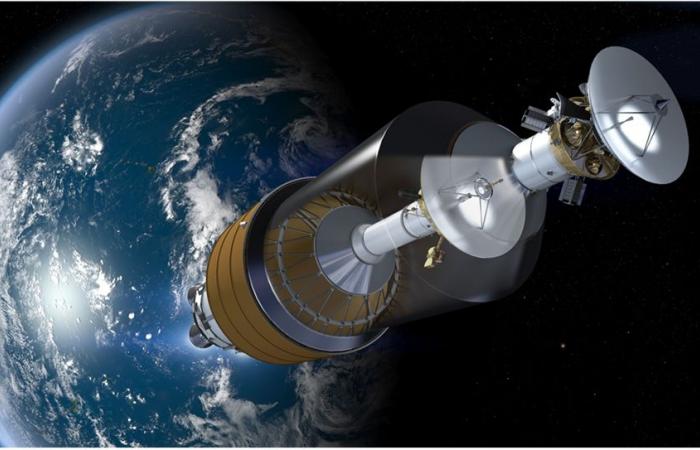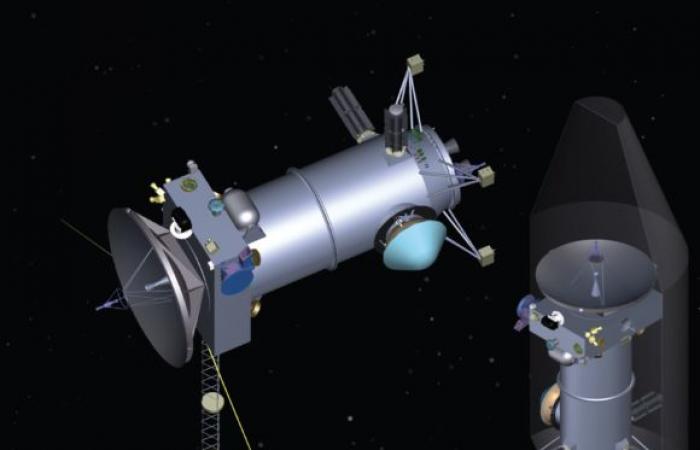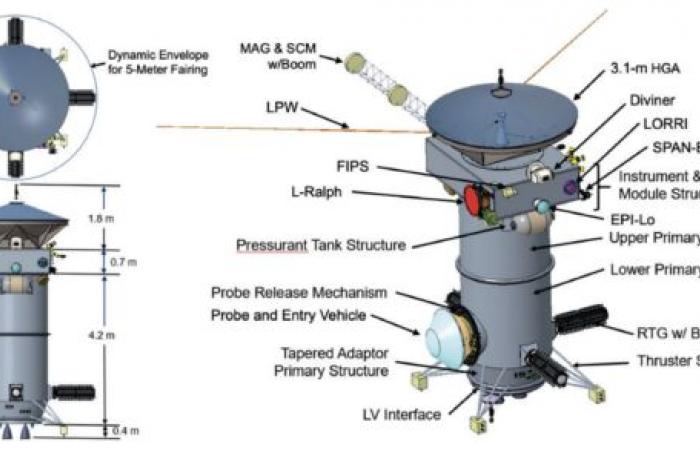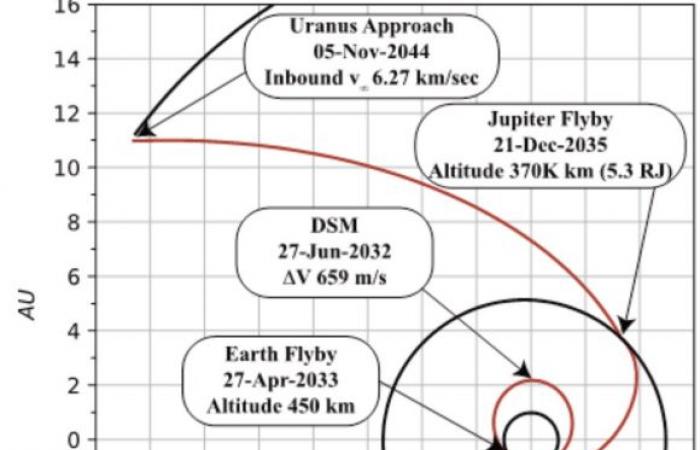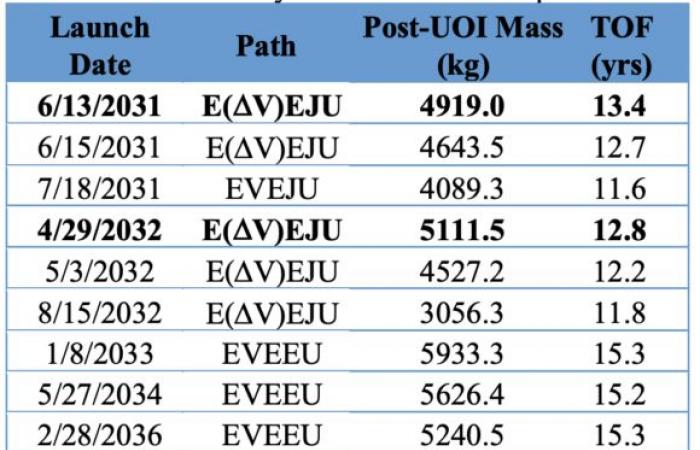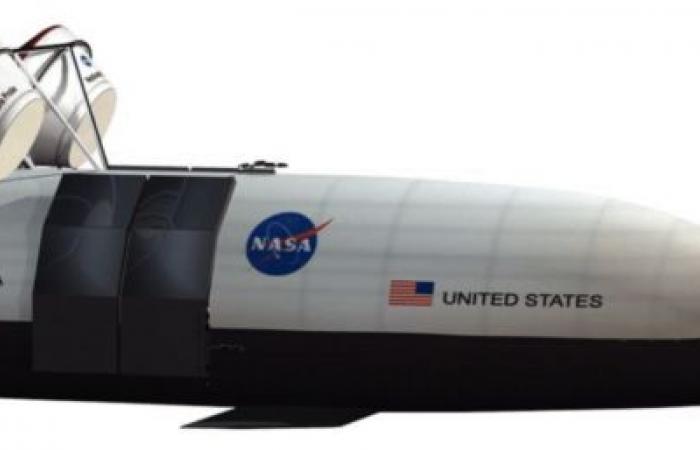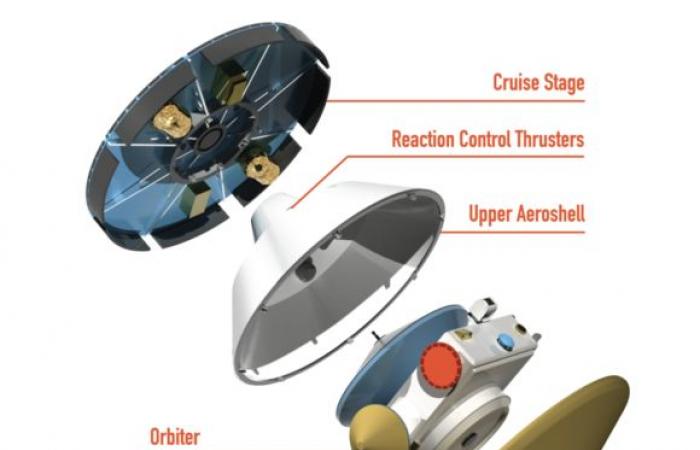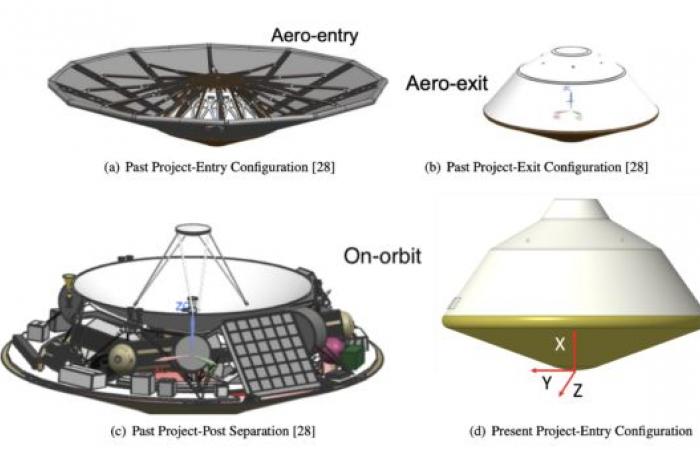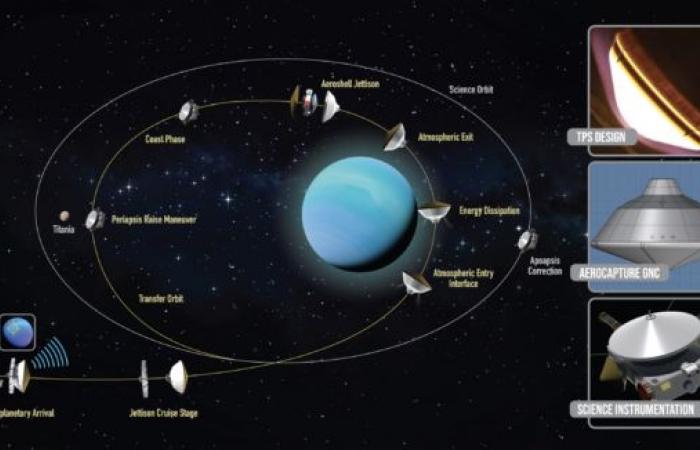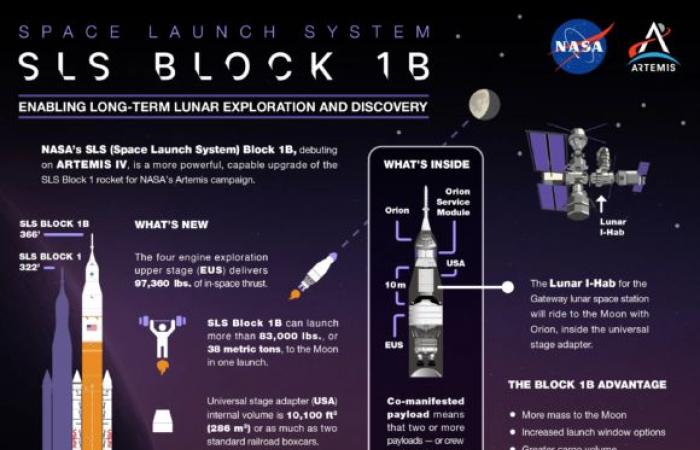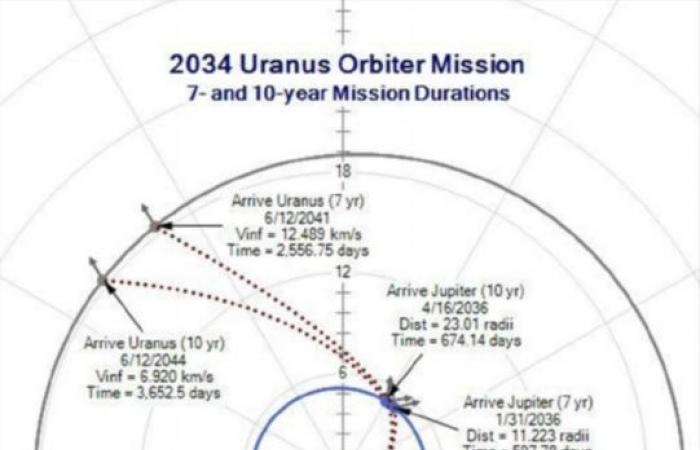One of the priorities of the American scientific community is the study of Uranus. Two years ago NASA decided that the next objectives of the most complex missions of the space agency in the outer Solar System should be Uranus and Enceladus, thus settling a decades-long debate on whether the priority should be Uranus or Neptune. The mission to Uranus has been provisionally called UOP (Uranus Space Telescope).Uranus Orbiter and Probe), indicating that the ship must be an orbiter so as not to limit itself to flying over the planet and, in addition, it must carry a probe to analyze the planet’s atmosphere in situ. UOP is currently a mission proposal that has not been formally approved, although NASA hopes to be able to launch it between 2031 and 2038. But there is a problem and that is that before being approved the agency must specify the general design and objectives of the mission. mission, which requires a relatively modest budget, but which is by no means negligible. Unfortunately, for now there is no money to carry out the mission on schedule.
The reason is that the MSR mission to bring back samples from Mars has created a huge black hole in NASA’s planetary budget, and as a result, UOP sees its schedule in jeopardy. And this is a problem, because time is running against UOP on two fronts. First, because the most favorable launch windows will take place at the beginning of the next decade. This is because UOP must take advantage of Jupiter’s favorable alignment to reach Uranus sooner. Depending on the final mass of the probe, from 2033 onwards the opportunities for a flyby of Jupiter are reduced or even disappear. The other time horizon is 2050. In that year, the equinox will occur on Uranus, so from then onwards the hemisphere that Voyager 2 could not see in 1986 will be increasingly less illuminated (remember that Uranus has a high inclination of its axis of rotation and “spins upside down”). For this reason, NASA’s plan for UOP was to launch in 2031 (or at the latest 2032) on a Falcon Heavy, flyby Jupiter in 2035, and arrive at Uranus in 2044, in time to observe both illuminated hemispheres, with special emphasis on the hemisphere opposite that observed by Voyager 2.

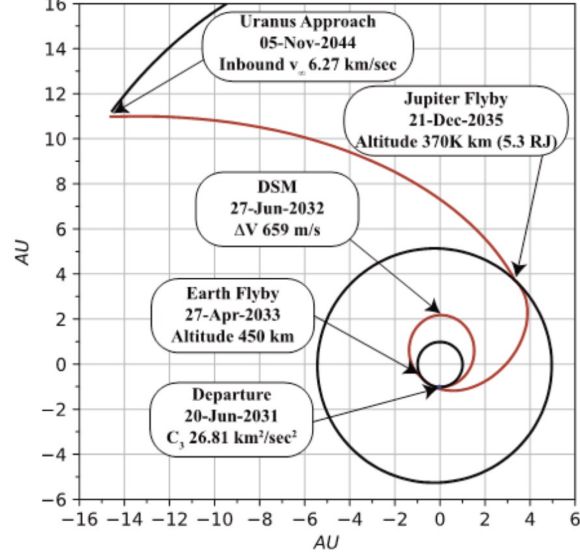
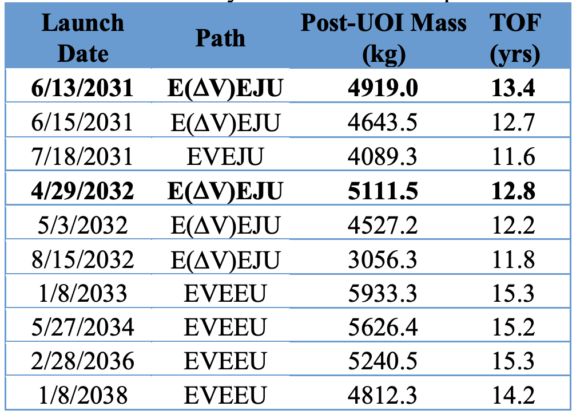
To solve this problem, there are only two options: either we use a more powerful launcher and thus reduce the flight time, or we reduce the mass of the probe (or both). Regarding the last point, reducing mass is a complex issue because UOP is a Flagship-type mission that must carry a significant number of scientific instruments, a high-gain antenna to ensure efficient communications from Uranus orbit, three radioisotope generators (RTGs) and, above all, fuel to place the probe in Uranus orbit. Propellants account for no less than 60% to 70% of the probe’s mass (about 1,800 kg in the basic 2022 design). How to reduce this mass? One very interesting possibility is aerocapture. This procedure allows the planet’s atmosphere to be used to slow the craft from a hyperbolic trajectory relative to the planet to orbital speed. In exchange, the probe must be surrounded by a heat shield throughout the flight to Uranus.
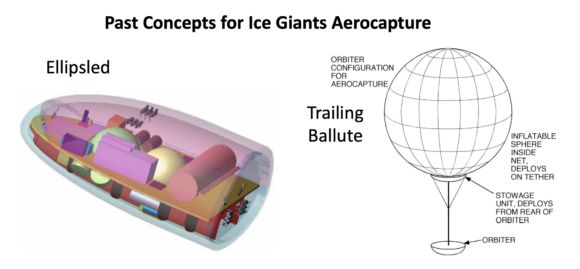
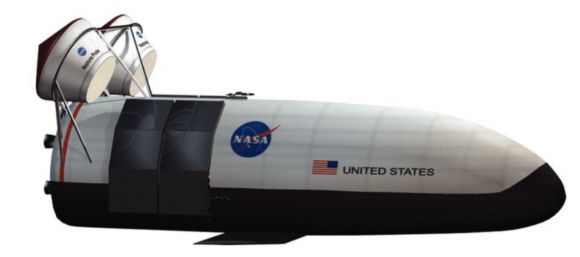
Many aerocapture studies have been carried out for missions to the outer planets, although most are based on lifting bodies or ballutes, relatively complex to design and operate. However, recently NASA has carried out studies that conclude that a probe with a heat shield with a shape identical to that used by the Martian rovers Curiosity and Perseverance – with an angle of 70º – could carry out an aerial capture without problems (the studies have analyzed diameters of 4.5 and 5 meters for UOP). Thanks to aerocapture, UOP would have a final mass of 5,500 kg instead of the 8,300 kg of the chemical-powered variant.
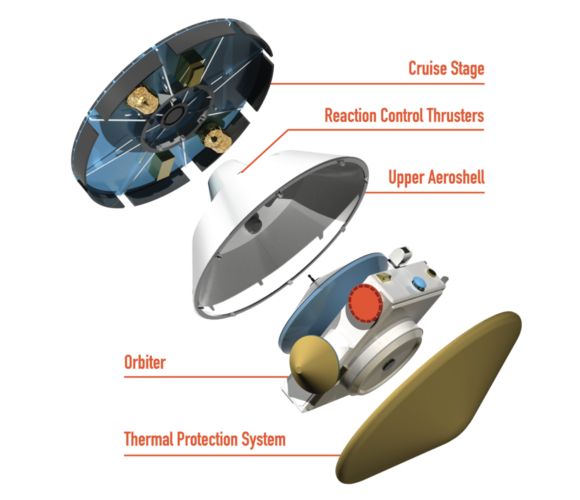

However, aerocapture has other drawbacks, the main one being that no one has ever tried it before. Aerobraking techniques have indeed been tested on multiple occasions on Mars and Venus to reduce the apogees of orbits, but no aerocapture has ever been carried out. Furthermore, in the case of Uranus, it must be taken into account that the speed of entry into the atmosphere would be about 27 km/s, compared to more than 6 km/s on Mars. Fortunately, the probe does not have to descend into the deep layers of the atmosphere, only slow down enough to remain in orbit of Uranus, so the thermal load and deceleration would actually be less than those encountered during the descent of a probe on Mars (between 3 and 3.5 g of deceleration on Uranus with aerocapture compared to 11.3 g on a descent to the surface of Mars). On the other hand, the fact that Uranus’ atmosphere is composed mainly of hydrogen and helium makes radiative heating very low compared to an atmosphere of carbon dioxide or nitrogen.
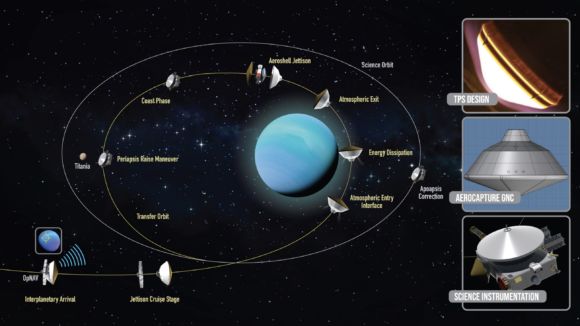
As we said, if aerocapture is one of the solutions, the other, and more obvious, is to use larger launchers. With aerocapture, if we use SpaceX’s Falcon Heavy —remember that it is the launcher selected for this mission— it is possible to reduce the flight time to Uranus from 13 to 9 years, in addition to allowing launch windows that flyby Jupiter until 2033. Since this date is unlikely due to budgetary problems, a launch in 2038 using the Falcon Heavy with aerocapture and without a flyby of Jupiter would take 12 years to reach, right on time for the equinox. With even more powerful launchers and aerocapture, such as the SLS Block 2 (plus a Centaur stage) or Starship, it would be possible to reach Uranus directly in just 6 or 7 years, although flybys of Jupiter until 2035 could be used to reduce the flight time to just 5 years. In this case, aerocapture would eliminate another problem, which is that for more direct trajectories, even more fuel would be needed to slow the probe down in orbit around Uranus. With aerocapture, a very energetic trajectory such as that provided by the SLS or Starship would not be a problem.
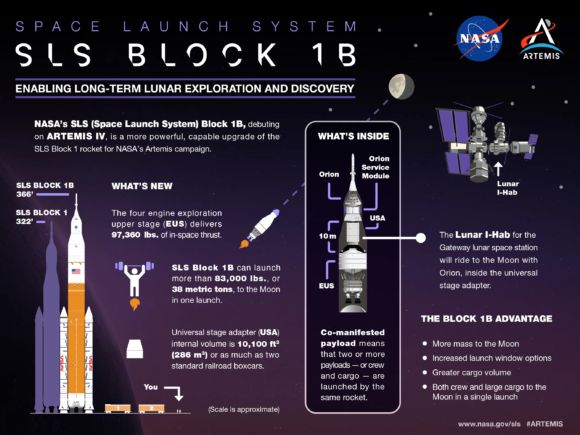

Therefore, aerocapture seems the solution to save UOP, although it is still necessary to refine many models to be clear that it will work the first time (for example, it is necessary to study the thermal regime resulting from having three RTGs inside a thermal shield during many years, although the Dragonfly probe will provide data on this by carrying an RTG to Titan for about 8 years). Without air capture, even using large launchers the flight time increases. Boeing—main contractor for the SLS—has been proposing a double mission to Uranus and Neptune for years using a single SLS (two probes weighing about 6.5 tons each), but with chemical propulsion it would take 16 years to reach Uranus and 18 to Neptune. (leaving aside that there is simply no money to finance a mission of this type with two probes instead of one).
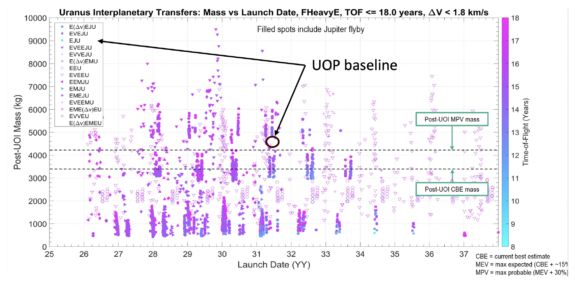
As we can see, aerocapture would allow the UOP mission to be launched later in the next decade, perhaps without the need to flyby Jupiter, and would allow the use of huge launchers such as the SLS or Starship. Will NASA dare to change the UOP design for a more ambitious option to reach Uranus sooner? Another alternative is to accelerate development so that UOP can be launched early in the next decade. As we said, NASA does not have the money for this option, but if it joins forces with the ESA, perhaps there would be a chance.
References:
- https://ieeexplore.ieee.org/document/10521306
- https://ntrs.nasa.gov/api/citations/20230016921/downloads/v2Uranus_FlagshipOrbiterProbe_Using_Aerocapture.pdf
- https://ntrs.nasa.gov/api/citations/20230017193/downloads/Aerocapture_Uranus_Overview_AIAA_SciTech_Dutta_v2.pdf
- https://www.hou.usra.edu/meetings/lpsc2024/pdf/1285.pdf
- https://nap.nationalacademies.org/read/12554/chapter/5#75

